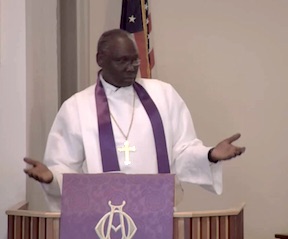Not too many years ago, the idea of reaching mass audiences with the Gospel using a form of electronic mass media was relegated to churches with deep pockets who could broadcast regularly on television or radio. The notion that a small congregation could reach out to the entire world without leaving their church building was almost laughable. But that once-laughable notion is now reality through the use of live video streaming and its steadily declining costs. What once required studios, trained technicians, and massive equipment expenditures can now be done (with less production quality) with a smartphone, free apps, and an internet connection. A congregation in Minnesota can (and does) reach viewers in India, Denmark, and Australia. A congregation in Nebraska can stream the Gospel to Sudanese in Ethiopian refugee camps and other Nuer-speaking people scattered around the world. Another in Colombia can reach Spanish speakers worldwide with the message of salvation by grace through faith in Jesus Christ! Those three congregations are not only ideas, they are reality. And they all serve as good examples of what God can accomplish through this medium.
In the following three examples are stories of Christians who want to use technology, as well as traditional means, for outreach to their communities and to the world. That's something important to note: no technology can fully replace all other methods of outreach. Live streaming is simply another medium that can be combined with others to proclaim the Word of God.
Peace Lutheran Church, North Mankato, Minnesota
The Peace congregation started their live streaming almost as an afterthought. The rapidly-growing congregation was quickly outgrowing their building and wanted overflow crowds on many Sundays to be able to see the pastor at the altar and pulpit. A system was devised to show live images of the service in two different areas of the church.

Inreach
No one knew what to expect. There were a few concerns three years ago when the first service went live on Easter Sunday. Would anyone watch? Would members stay home and watch the service instead of coming to church? Those fears were quickly dispelled when we began receiving emails, notes on Facebook, and phone calls letting us know that people were watching. Members didn't stop coming. In fact, members who were sick at home began watching the live stream and members who were traveling without a church nearby also began watching — all who without the live stream would simply have missed church.
Outreach
Soon, emails from people no one in the congregation had met personally started coming — emails from people watching in other countries. The service is streamed only in English, but has regular viewers in at least fifteen countries.
Two local families have joined the church after watching the service, then coming to visit, and finally receiving instruction from the pastor. Much more can be done as the congregation discusses ways to reach more with this technology.
iGlesia Luterana Cristo

What if your church service could be available to virtually every Spanish-speaking person in the entire world? That's the idea behind iGlesia Luterana Cristo, a project of the WELS.
This unique ministry combines a live church service in Medellín, Colombia, with the ability to ask questions about the service or sermon, live or after the service, through a chat window. While Pastor Henry Herrera leads the service and preaches, other pastors (who happen to be in other locations, but that doesn't matter) are available to answer questions via a chat window. Before the service, these pastors greet people as they come online, just as a pastor might greet members and visitors when they enter the church building. Following the service, everyone is invited to join online discussions, which can continue throughout the week. Liturgy, hymns, and recorded sermons are all available on the website for everyone.
This project, which began live streaming in September of 2015, also provides visitors with the opportunity to learn and study Christian teachings through its sister site (and predecessor), Academia Cristo.
View the streamed worship in Spanish here. Also look at the online school on the Academia Cristo website.
Good Shepherd Lutheran Church, Omaha, Nebraska
The latest example of reaching out with the Gospel through live streaming is Good Shepherd Lutheran Church in Omaha, Nebraska. Good Shepherd began streaming their services in February of 2016 with the goal of reaching out to their community as well as a very specific group of people on another continent.

Omaha is the home of many Sudanese immigrants and refugees. Good Shepherd also hosts a Sudanese congregation who meet weekly for worship. This congregation's services are also being streamed with the goal of reaching many who are still in Sudan or scattered throughout the world because of the situation in their homeland.
Here is the Sudanese worship site.
Conclusion
Technology is neutral. How we use technology is not neutral. And one of the best uses of technology is to spread the Gospel of Jesus Christ to a sin-darkened world. God has provided His Church with the ability to reach vast numbers of people in desperate need of the Gospel—anyone with internet access.
As we seek ways to reach the lost in all areas of the world, we look to our gracious God in thankfulness for all the opportunities He has given us. In this time of ever-tightening budgets, God has given us an inexpensive way to reach many people with His message so that the Holy Spirit may work and strengthen faith in the hearts of the hearers. May God grant us wisdom and courage to use what He gives us to His glory for the salvation of many souls.
Addendum
The first question many ask is, "How much does it cost?" Of course, like anything else, there is not a simple answer. A congregation can install a 2- or 3-camera system like those in the examples for between $5,000 and $8,000. Additionally, a streaming service provider is needed. There is a monthly fee, which varies widely between providers. At the time of this writing, I highly recommend DaCast. These prices assume the congregation is willing to help with the installation or follow directions to install the equipment themselves.
Return to original language with "show original" button at top left.

Discussion
I think that its success can be considered in a diffusion of innovations framework. It was already apparent at that time that streaming services were catching on with a variety of groups, but not yet with the Hmong. Starting it when we did with that culture made success more likely, since it had observably already been adopted and diffused through other systems who were simply earlier adopters.
Since this is a technology that has pretty thoroughly diffused, it might just be down to relative advantage at this point. There should be a reason that our online services offer a significant advantage over what we are hoping to replace. If we're hoping they're replacing nothing, so much the better. If we're hoping they're replacing other streams (which is much more likely at this juncture) then they should be notably better in some regards. That's where productive word of mouth (theoretically) comes from.
Alternately, specifically identifying groups where this has not yet diffused and then generating media targeted at them would produce the greatest chance of success. As I said though, those groups are diminishing rapidly in number at this point.
When watching a live stream, there are a few things you can do to make things run more smoothly. First, make sure you have a high-speed internet connection. It needs to be over 1Mbps to watch a stream without problems and over 1.5Mbps to watch an HD stream. You can easily test the connection at: www.speedtest.net. If you are using a mobile device or tablet, there is a free app available from the company (Ookla).
If you watch on a phone or tablet, the quality is automatically adjusted to the speed your device and connection can handle. That's why often a phone works better than a computer. If you watch on a computer and you're having problems, you can try adjusting the quality manually (usually the setting is at the bottom of the video window). Also, it's best to close any other programs so that the computer's resources can be dedicated to the video and audio. Hope this helps!
Here is the workflow we use at Peace Lutheran in North Mankato, MN:
1. Begin live streaming 5 minutes before service begins.
2. Start recording just before the service starts.
3. End recording after announcements.
4. End streaming about 1 minute after announcements—this allows for all viewers to see the announcements, since there is a delay in live vs. streaming.
5. Clip sermon from the recording and save as separate file.
6. Upload sermon and service as separate files to Vimeo. We have 5 categories on Vimeo and each file is categorized as it’s uploaded.
We have a free plugin installed on our website that reads our Vimeo account and immediately shows the newest uploads. We also have a plugin on Facebook that posts each video as soon as it’s ready on Vimeo. Step 5 (above) takes about 5 minutes to complete. As soon as step 6 is started, you can walk away. It can take up to an hour or two (depending on the internet connection) to upload to Vimeo, but you don’t need to be there. Simply set the computer to go sleep after 2 or three hours, turn off the monitor and leave.
You can see the end results at: http://peacemankato.com/video/